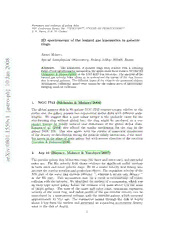
3D spectroscopy of the ionized gas kinematics in galactic rings PDF
Preview 3D spectroscopy of the ionized gas kinematics in galactic rings
Formation and evolution of galaxy disks ASP Conference Series, Vol. **VOLUME**, **YEAR OF PUBLICATION** J. G. Funes, & E. M. Corsini 3D spectroscopy of the ionized gas kinematics in galactic rings. Alexei Moiseev 8 Special Astrophysical Observatory, Nizhnij Arkhyz 369169, Russia 0 0 2 Abstract. The kinematics of galactic rings were studied with a scanning Fabry-Perotinterferometermountedinthe multi-modefocalreducerSCORPIO n (Afanasiev & Moiseev2005)attheSAORAS6-mtelescope. Theanalysisofthe a J ionized gas velocity fields allows us to understand the nature of the ring forma- tioninseveralgalaxies. The differenttypes ofthe ringsin the presentedobjects 0 (resonanced, collisional, polar) were caused by the various sorts of interactions: 1 merging, head-on collisions. ] h p - o 1. NGC 7742 (Silchenko & Moiseev 2006) r t s a The global gaseous disk in Sb galaxy NGC 7742 counter-rotates relative to the [ stellar one; the galaxy possess two exponential stellar disks with different scale- 1 lengths. We suggest that a past minor merger is the probable cause for the v star-forming ring without global bar; the ring might be produced as a res- 0 onance feature by tidally induced oval distortions of the global stellar disks. 5 Knapen et al. (2004) also offered the similar mechanism for the ring in the 5 1 galaxy NGC 278. This idea agrees with the results of numerical simulations . of the density re-distribution during the galactic tidally interaction, if the satel- 1 0 lite moves in the plane of main galaxy but with reverse direction of the rotation 8 (Tutukov & Fedorova 2006). 0 : v i 2. Arp 10 (Bizyaev, Moiseev & Vorobyev 2007) X r a ThepeculargalaxyArp10hastworings(theinnerandouterone),andextended outer arc. The Hα velocity field shows evidence for significant radial motions in both outer and inner galactic rings. We fit a model velocity field taking into accounttheregularrotationandprojectioneffects. Theexpansionvelocityofthe −1 −1 NW part of the outer ring exceeds 100kms , whereas it attain only 30kms at the SE part. This asymmetric may be a result a substantially off-center collision with the intruder. We identified the nucleus of a companion, which was an early-type spiral galaxy before the collision with mass about 1/4 the mass of target galaxy. The sizes of the inner and outer rings, maximum expansion velocity of the outer ring, and radial profile of the gas circular velocity can be reproduced by a near-central collision with the intruder galaxy, which occurred approximately 85 Myr ago. The companion passed through the disk of Arp10 about 3 kpc from the nucleus and generated an expanding asymmetric density wave in the disk of Arp10. 1 2 Moiseev Figure 1. Arp 212: the Hα velocity field (left); the mask of kinematic distinct components with Hα isophotes (middle); the layout of the circular orbitsorientationissuperposedonthe photographicfromArp’satlas(right). 3. Arp 212 (Moiseev 2008) Sa/Specgalaxy Arp212 happenstohaveagreatdealofgas anddustassociated with violent star formation. Hα emission concentrates in the center region and also in individual knots distributed in the external curvilinear structures which are possible signs of recent interaction (Cairo´s et al. 2001). On the ionized gas velocity field we detect regular rotation at r < 3 kpc. The line-of-sight −1 velocities in the external knots have systematic (up to 70-80kms ) deviations from the inner part rotation pattern. The analysis in the frame of tilted-ring approximation shows that external knots rotate on stable orbits, the systemic velocity and amplitude of the rotation curve agree with same parameters on the inner radii. However, the spatial orientation of the rotation plane differs for inner and outer parts. The angle between the ‘main plane’ and the ‘outer ring’ reaches ∆i> 75◦ at the distances r = 4−5 kpc. Therefore the outer HII knots in the Arp 212 have an external origin and rotate in a distinct ring. The inner parts of this ring are warped, the outer ones may rotate in the plane nearly orthogonal to the plane of the inner gaseous disk (see Fig. 1). Acknowledgments. Thisworkwas partlysupportedbytheRussianFoun- dation for Basic Research (project 06-02-16825) and by the grant of President of Russian Feredration (MK1310.2007.2) References Afanasiev,V.L.,&Moiseev,V.L.2005,AstronomyLetters,31,193(astro-ph/0502095) Bizyaev, D. V., Moiseev, A. V., & Vorobyov,E. I. 2007, ApJ, 662, 304 Cair´os,L. M., Caon, N., V´ılchez, J. M., Gonz´alez-Perez,J. N., Mun˜oz-Tun˜o´n, C. 2001, ApJS, 136, 393 Knapen, J. H., Whyte, L. F., de Blok, W. J. G., van der Hulst, J. M. 2004, A&A, 423, 481 Moiseev, A. V. 2008, Astrophysical Bulletin, submitted Silchenko, O. K., & Moiseev, A. V. 2006, AJ, 131, 1336 Tutukov, A. V., & Fedorova, A. V. 2006, Astronomy Report, 50, 785
